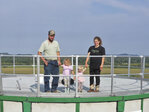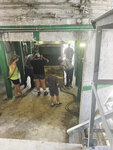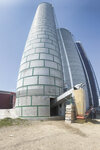


HUMBIRD, Wis. — Zach Janke wanted a new silo with the convenience of bottom unloading and the ability to make drier feed have a longer shelf-life.
“I love all my silos,” Janke said. “I am a silo guy and like being in the feed room, out of the elements.”
Janke and his wife, Abby, milk 88 cows in a tiestall barn and farm 400 acres of land. The Jankes built their first two silos in 2014.
They recently built a Greenline Silo, a poured concrete silo, that is 24 feet-by-124 feet with 111 feet of feed storage space. There is a 15-inch floor and a 6-inch poured concrete flat roof. It also has an 8-foot walk-in basement. Janke said they are still working on a capacity chart but are estimating the silo to hold 11,000-15,000 tons of feed.
When picking out a silo, Janke had a conversation with Marvin Reiff, creator of the Greenline Silo, about building a silo on his farm.
“I told him I want it so there is a great big hole in the floor and I want an auger to bring the feed out from the cutter chain,” Janke said. “I told him (Reiff) I want to do it differently.”
After that conversation, Janke said that Reiff took his suggestions and made them better to create the Greenline Silo.
During the process of building and operating the silo, Janke said there were challenges that they faced and had to overcome since this was the prototype.
“(Problems) that we have had are fixable the next time or just a simple fix that we can do on our own,” Janke said. “It was a lot of trial and error.”
At the open house Janke hosted Aug. 7-8, they aimed to test how much feed the silo could unload in one minute. Based on the number of times the conveyor circled and the weight of each load dropped, they estimated that around 1,600 pounds per minute of corn silage could be unloaded. The speed for haylage is half as fast, so delivery would be around 800 pounds per minute, said Janke.
The Jankes like to have haylage at about 45% moisture or less and silage at 55% or less. Dry feed is less acidic for the cows and is a sweeter, better-smelling feed. If the haylage gets dry enough it will not lose as much of the sugars in the fermentation process. Janke is working toward having a drier haylage for his cows with the help of the silo.
“You can see a huge difference in the wear in the chain life and the unloader life on wet feed versus dry feed,” Janke said.
Janke opted for the poured concrete silo because the sun can penetrate less. There is more insulation and it is harder for the sun to get through 6 inches of concrete than a different type of silo wall.
The unloading system runs off one 30-horsepower electric motor. Janke said it is pretty efficient. The unloading system is all automatic.
“One thing that I love is if something happens it’s not like we are completely out of business,” Janke said. “We can completely unplug the automatic programming and use manual levers.”
While having the same cutter chain as a Harvestore silo, the Greenline Silo does not have a conveyor chain. Rather the feed is collected by a four-foot turn table with an extension arm and is then dropped through a central hole and conveyed out.
“Anything the cutter chain brings to the center of the silo drops away from it and is out of the way,” Janke said. “That’s what gives it its capacity.”
The cutter arm sits on a turn table and has the ability to slide in and out. At its shortest length, it is 30 inches away from the wall and at its longest, it is 1 inch away from the wall. It can move back and forth to any length in between.
At shutdown it goes into its shortest length making it easier to start because it is retracted. Once it gets fully started and the pounds per square inch is low enough it starts extending and going into long-arm mode.
Within the silo there is an inventory monitor called SmartBob. A cable with a weight on the end of it, connected to a timer, drops into the silo until it hits the feedline then lifts up. The monitor calculates distance as it is pulling the cable back up. This measures the feet of feed in the silo. Janke has it set to measure once a day.
Janke currently has first, second and third crops in the silo.
“I do like it better than the other two (silos),” Janke said. “You can be filling it and feeding out of it at the exact same moment.”
Janke’s other silos are a Harvestore and a top unload silo.
“That’s one benefit you don’t have to climb or pull the unloader up (in a top unload),” Janke said.
Compared to a Harvestore, Janke said the accessibility to the unloader is a lot better. He can get right at the unloader in the Greenline silo to look at something or work on it.
“You can visually see what the cutter chain is doing instead of in a Harvestore, (where) it’s kind of guesswork since you obviously can’t see through (the wall),” Janke said.
Janke said he really likes the silo compared to a forage pile or bags since he does not have to worry about the outside elements.
“There’s no mud, plastic to deal with or feed waste,” Janke said.
Comments
No comments on this item Please log in to comment by clicking here